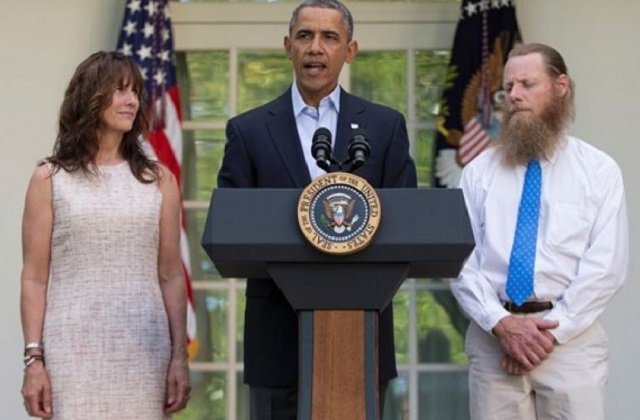Through eight episodes of Serial’s second season, we’ve heard from Sgt. Bowe Bergdahl about the conditions of his imprisonment by the Taliban and his deterioration of his mental state during five years of captivity. Episode nine, titled “Trade Secrets,” begins with Bergdahl’s release back to the United States.
What goes through one’s mind when seeing U.S. soldiers for the first time in five years? What does it feel like to try and speak, to try and communicate your thoughts, when you’ve barely spoken for such a long time? When your world has been nothing but small rooms, what is it like to suddenly be on a helicopter in the air? What does freedom feel like in those initial moments?
The episode doesn’t dwell on this for very long, except to get Bergdahl’s brief perspective on immediately going into “intel mode” when he found out he was being retrieved by Special Forces. He began to give names, try to describe locations, etc. But none of that mattered in the moment. He had to be taken to a plane in Afghanistan. What Bergdahl didn’t know was that those soldiers were on a schedule, because at Guantanamo Bay, Cuba, another plane was waiting to transport five Taliban soldiers who were being released as part of a prisoner trade.
That’s just about all we hear from Bergdahl in this episode, as host Sarah Koenig zooms her camera out wide to look at the far bigger picture with which this soldier’s imprisonment was involved. In both the United States and Afghanistan, this trade was viewed curiously. Did the U.S. really just negotiate with terrorists and release Taliban prisoners? In Afghanistan, the question was about the American soldier released. He must have been a general, if the U.S. was willing to release members of the Taliban in exchange. People were perplexed to discover Bergdahl was just a private.

Considering what he went through, it seems almost cruel to say that Bergdahl’s release was a line item in negotiations between the United States, the Taliban and Afghanistan. But that’s essentially how it stood in the bigger picture. The U.S. was hoping to end the war in Afghanistan, to reach a peaceful settlement. The Taliban was complicating those negotiations with their own list of demands, ones Afghanistan didn’t want to accommodate. These discussions included several items or requests meant to build confidence or show good faith. Bergdahl was one of them.
Part of the problem with negotiations between the U.S. and Afghanistan was that the military wanted to handle the solution one way, while diplomats preferred other methods. Which side served the other’s best interests often led to clashes. Were U.S. ambassadors “wingmen” to the military? Or should the military act as “handmaidens” to the diplomats? Naturally, the military thought the solution was to fight (a stance President Obama also shared). Diplomats sought a more political resolution to the conflict.
What wasn’t made public at the time is that the Taliban wanted these peace talks. They wanted to be recognized as a separate faction from Al Qaeda and a political body by Afghanistan. The Taliban wanted an office in Qatar, which would seemingly make them legitimate. In return, the U.S. wanted the Taliban to stop fighting, support the Afghan constitution, and expand rights for women and girls.
Obviously, this situation required more careful treatment, but there was bungling on both sides that caused negotiations to break down at several points. (Notably, the Taliban wanted these talks to remain secret, which didn’t happen.) The death of diplomat Richard Holbrooke, the strongest advocate for a non-military resolution, certainly did not help the process. Meanwhile, Bergdahl’s imprisonment dragged on and on.
A major sticking point in negotiations became which prisoners the United States would release. Originally, the Taliban wanted captives that were being held on an air base in Afghanistan to be freed. But eventually, they aimed higher, perhaps sensing some leverage in the situation. The Taliban wanted five of its soldiers released from Guantanamo Bay, and wanted to choose which prisoners were freed. The two sides were at a stalemate, one that went on for two years.
Finally, in 2014, the Taliban reopen negotiations by reaching out to the United States. The catch is that they’re not interested in peace talks and helping the U.S. navigate its military out of the Afghanistan conflict. The Taliban wants to discuss a prisoner swap again. Through her reporting, Koenig surmises that the Taliban wants those specific five prisoners released because those soldiers surrendered to the U.S., and to get them back would represent a victory of sorts. In return, Bergdahl would be released.
The White House agreed to those terms after receiving proof of life. The urgency to get Bergdahl back only increased upon seeing his condition in that video; he’s incoherent and doesn’t look as if he’ll last much longer in captivity. Additionally, the U.S. had to get Bergdahl out of Afghanistan before withdrawing troops and ending combat operations in the region. He couldn’t be left behind.
On May 31, 2014, the “mutual release,” as it was termed (it couldn’t be called a prisoner exchange), was finally completed. The episode ends with President Obama announcing in the Rose Garden with Bergdahl’s parents that our captive soldier has been freed. It was presumably a happy ending, especially for the Bergdahls, who were assured that there will be no punitive measures sought by the military as his imprisonment by the Taliban was punishment enough. Of course, we know it hasn’t quite worked out that way. That’s where episode 10 of Serial will pick up.
You can read all of our Serial recaps here.








